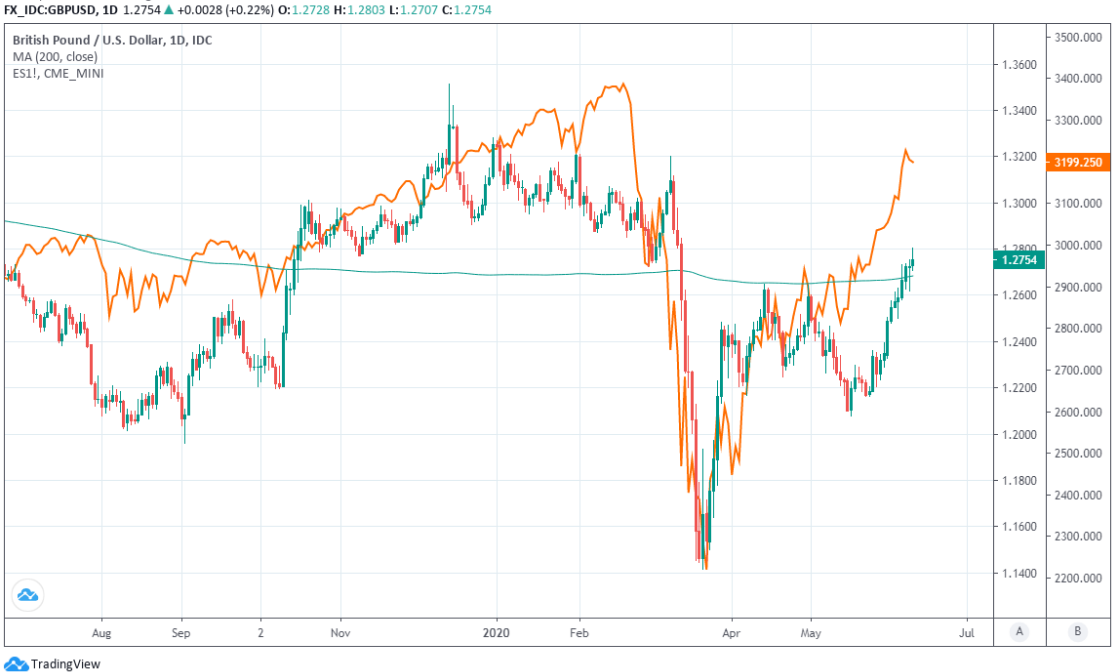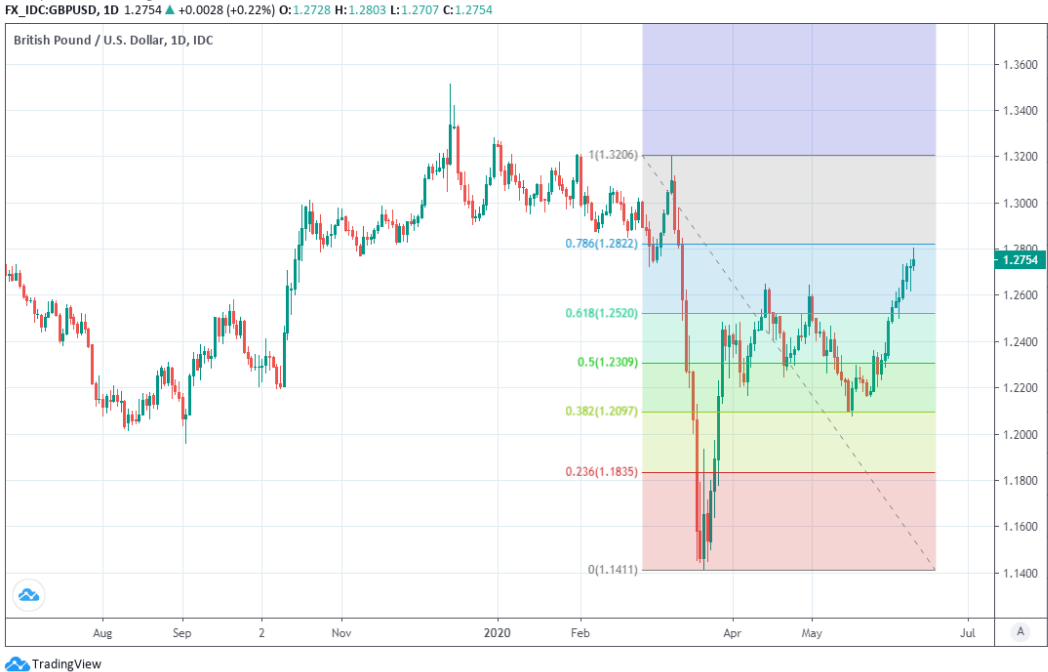Pound-to-Dollar Rate Near Highest Since March and Vulnerable to Setback
- Written by: James Skinner
-
- GBP/USD at highest since March but pares gains ahead of Fed.
- Could be in line for short-squeeze if Fed disappoints, EBC says.
- But focus turns to GDP data, economy on Friday, BoE next week.
- Botched school reopening prolongs risks as BoE decision looms.
Image © Adobe Images
Secure a retail exchange rate that is between 3-5% stronger than offered by leading banks, learn more.
The Pound-to-Dollar rate reached its highest since March on Wednesday but was nearing resistance on the charts and growing vulnerable to a set-back as a series of risks lurks just around the corner for the British currency.
Sterling rose against a weakening Dollar in what was its tenth consecutive gain on Wednesday but ran out of steam around 1.28 as stock markets softened ahead of the June Federal Reserve (Fed) policy update that will be an important influence on risk appetite and demand for the Dollar heading into the weekend.
The Pound-to-Dollar rate pared gains just ahead of the 78.6% Fibonacci retracement of its March fall located around 1.2822 as caution took hold amid uncertainty over whether the Fed will be able to say or do anything that keeps the recovery of risk assets in full swing after 10 weeks of mostly solid gains.
"A cautious outlook from the Fed could also pour cold water on the rampant V-shape recovery narrative that has been raging since the end of May and see the USD stage a strong, counter-trend, "risk-off", bounce," says Eric Bregar, head of FX strategy at Exchange Bank of Canada. "Should the Fed do the opposite (unleash a much more optimistic outlook and bring forward the [yield-curve-control] debate as the market has been speculating), we think the resulting surge in risk sentiment could see the floor fall out from underneath the dollar as the leveraged fund market is still holding massive, unprofitable, long USD positions against the high beta “risk-on” currencies (CAD, AUD, and GBP)."
Bregar says if the Fed keeps the party going then a 'short-squeeze' could force a reversal among investors who've been betting against the Pound-to-Dollar rate in recent weeks, which would lift it to new highs. Chicago Futures Trading Commission data shows those wagers rose in late May.
Above: Pound-to-Dollar rate alongside S&P 500 index (orange line). Crosses 200-day moving average.
However, short-sellers would only be squeezed if the Fed avoids smearing the rose-tinted glasses that've got investors looking for a robust rebound by the global economy and continued gains in the stock markets.
Should the rose-tinted glasses end up dirty then this week's Pound-to-Dollar rate move higher might come undone.
Sterling had risen just less than 4% against the greenback for the month of June on Wednesday and by 12.2% from its low on March 18, taking it across the 200-day moving-average at 1.2687 on Monday before advancing from there, but it still faces risks relating to the economy, the Bank of England (BoE) and Brexit that could weigh on it again in the coming days.
"Sterling has extended gains beyond the 200Day MAV at 1.2687," says Jeremy Stretch, European head of FX strategy at CIBC Capital Markets. "Yet despite such risk fuelled impetus, we remain wary of chasing the Sterling rally as there can be upcoming macro and political resistance."
Brexit negotiators agreed to continue trade talks through the summer last week, removing an artificial deadline from the path of the Pound while encouraging an improvement in sentiment that's helped it catch up with other 'high beta' currencies. But the talks themselves have gone nowhere and once past the Fed, attention could quickly revert to the UK economy and BoE.
Above: Pound-to-Dollar rate with Fibonacci retracements of March fall.
GDP data for April, the first full month of 'lockdown', will be released on Friday at 07:00 and the market is looking for a -18% month-on-month decline in the services heavy economy. The data will come as the government struggles to get the nation's schools to reopen, with plans for a complete return of all children by September called into question this week, and might undermine appetite for the British currency especially if it's seen impacting the outlook for BoE policy.
"Comments by Governor Bailey suggest that the ‘no-negative’ policy is under review. At the very least it is not being explicitly ruled out, as was the case with his predecessor. While it is true that the global policymaking community now has more experience with negative rates, there is still a lack of a consensus on its overall impact. The UK would also risk being the first major current account deficit country to go negative," says Geoff Yu, a strategist at BNY Mellon.
The BoE is widely expected to increase its quantitative easing target next Thursday so as to keep pressure on government bond yields and help accommodate the increased supply that's due to hit the debt market this year as a result of coronavirus-related borrowing.
But the danger for Sterling is the BoE goes further than markets expect it to or that it seeks to keep the discussion about negative interest rates alive. So while Sterling has had the wind in its sails this week, it might not be long before domestic headwinds are leaning against it again.
"No decision is expected by the August inflation report and an economic recovery by then may obviate the need for lower rates, but we would expect headwinds for sterling if the option remains on the table," BNY's Yu says.






